Sunday 7 June 1942
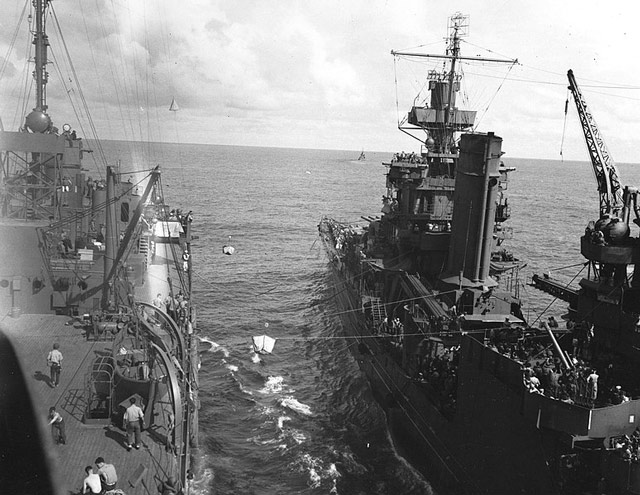 |
| "USS Portland (CA-33), at right, transfers USS Yorktown survivors to USS Fulton (AS-11) on 7 June 1942, following the battle of Midway. Fulton transported the men to Pearl Harbor." Naval History and Heritage Command 80-G-312028. |
Battle of the Pacific: US aircraft carrier USS Yorktown (CV-5) sinks just after dawn on 7 June 1942, marking the definitive end of the Battle of Midway. Yorktown capsizes due to the combined effects of previous Japanese naval air strikes and torpedoes from I-168. The Battle of Midway has been a decisive American victory, with the Japanese losing four fleet aircraft carriers and a cruiser.
Continuing with their grand operational plan whose main component already has been thwarted at Midway, the Japanese occupy Attu Island in the Aleutians. There is no opposition to the 1143 men of the North Sea Detachment, and it is unclear if the US even knows about this latest invasion for a day or two. There are only 44 US civilians and 42 Aleut natives on Attu. One US civilian, Charles Jones, dies during the Attu invasion of unknown causes. The Japanese send everyone to camps in Japan, with only 25 of the 86 inhabitants surviving the war. The Japanese also capture nine of ten US Navy sailors manning a weather station on Kiska, with the tenth man (wearing a summer uniform) evading capture in the interior for 45 days.
The Japanese now occupy two islands at the extreme end of the Aleutian Island chain (Attu and Kiska). The Japanese high command anticipates that the US Navy will intervene and sends two light carriers to the vicinity in order to stage an ambush. In fact, Admiral Chester Nimitz does intend to send USS Enterprise and Hornet to the Aleutians, but he has not yet issued the necessary orders.
While Admiral Raymond A. Spruance has chosen not to pursue the retreating Japanese fleet - a decision for which he receives criticism - the US Army Air Force decides otherwise. Major General Clarence L. Tinker, Commander, 7th Air Force, personally leads a bomber strike from Hawaii. He perishes when his plane crashes near Midway.
 |
| "Located in the southeast room of the visitors building of Manila American Cemetery and Memorial. Map was designed by Margaret Bruton and fabricated by P. Grassi American Terrazzo Company of South Francisco." Naval History and Heritage Command NH 114452. |
Admiral Frank Fletcher, who ceded command of US Task Force 18 around Midway Island due to the loss of his ship, the Yorktown, transfers his flag to aircraft carrier Saratoga, which has recently arrived from the US west coast. Saratoga departs Pearl Harbor today carrying replacement aircraft for the two remaining carriers involved in the battle. Fletcher thus is able to resume command of the task force on 8 June. He learns that Spruance has withdrawn to the east in order to refuel his ships and quickly orders search missions for the Japanese, who are heading back to Japan. However, the opportunity to continue the battle and "finish off the Japanese" has been lost.
While he has presided over the dramatic victory off Midway, Spruance manages to destroy much of the reputation he could have gained. This is due to his perceived lack of aggressiveness following the heat of the battle. Spruance's "discretion is the better part of valor" approach is controversial - then and now - and contrasts poorly with the aggressive tactics of Admiral "Bull" Halsey, who was unable to command the fleet at Midway due to health concerns. Now that Fletcher is back in command, Spruance is quickly reassigned from his field command to serve as Admiral Nimitz's chief of staff, though he does recover to have some important commands in 1943-1945.
Japanese submarine I-26 (Cdr Yokota) torpedoes and sinks 3545-ton US refrigerated freighter Coast Trader thirty miles off the Strait of Juan de Fuca on the US west coast. The ship is carrying refrigerated ammonia, which leaks due to the explosion and incapacitates some of the crew. There is one death. The remaining 56 men make it to a lifeboat, which local fishing vessel Virginia I tows to Neah Bay, and two rafts that Canadian corvette Edmunston (K-106) finds.
US submarine Grouper (SS-214) is mistakenly bombed by USAAF B-17 bombers looking for the Japanese fleet. It escapes undamaged, reflecting typical poor aim by level bombers against shipping in the Pacific.
 |
| "USS Yorktown (CV-5) sinking, just after dawn on 7 June 1942, as seen from an accompanying destroyer." Naval History and Heritage Command NH 106000. |
Battle of the Indian Ocean: Japanese submarine I-18 shells and sinks 2158-ton Norwegian freighter Wilford in the Indian Ocean off the Mozambique Coast. There are nine deaths and 34 survivors. All but two of the survivors, who are picked up by a Marinha Portuguesa gunboat, reach land in their lifeboats.
Eastern Front: In Crimea, German General Erich von Manstein begins Unternehmen Störfang (Operation Sturgeon Catch), the assault on Sevastopol. The port is well-defended, surrounded by rugged forests and bunkers that include 11 batteries and strong points north of Severnaya Bay.
The German 11th Army is weak, with many divisions seriously understrength. This is because Adolf Hitler is husbanding his fresh troops for the grand offensive, Case Blue, that he plans to launch in a few weeks. There are many fresh divisions and thousands of idle troops just north of the Crimea. It is an artificial manpower shortage, as opposed to the real one that are to come. Thus, Manstein must rely heavily on his artillery and airpower to make up for a weak thrust on land. Assisting the Germans are units of the Romanian Army, including the 1st Mountain Division and 18th Division, which are strong but lack their own artillery and air support.
 |
| Lahti L-39 anti-tank gun in use, 7 June 1942 (Martin Persson, SA-kuva). |
Aiding the assault are the Germans' heavy artillery that includes an 800 mm gun (Schwere Gustav), three 600 mm guns (Karl-Gerät self-propelled mortars), two 280 mm railway guns, two 420 mm guns, two 355 mm howitzers, and four 305 mm mortars. These massive artillery pieces have been firing at the Soviet defenses for days and have destroyed some key Soviet bunkers. The Luftwaffe's 8th Air Corps already has flown 3,069 sorties against the port, dropping 2,264 tons of high explosives and 23,800 incendiary bombs.
Following the massive preparatory bombardment, German 30 Corps attacks in the south while LIV Corps does so in the north. The southern attack stalls, but the LIV Corps makes good progress (this is the sector where the heaviest artillery has is located). The 132nd Infantry Division heads down the river while the 22nd Infantry Division attacks further east. The Soviets have planted numerous minefields that slow the Axis troops down.
For Manstein, it is a mixed picture, with some advances in the north, few gains in the south, and failed attacks by the German 24th and 50th Infantry Divisions. In LIV Corps' four divisions alone there are 2,357 casualties, including 340 men killed. In addition, some of the units are running low on ammunition. However, the Germans take the key Red Army defensive position at Belbek, and Red Army casualties also have been severe. With his attempt at a quick victory a failure, Manstein now is looking at a depressing battle of attrition against the numerous enemy forces unless he can get the attack moving in the coming days.
 |
| Focke-Wulf Fw-190A-2, 7./JG2, Theville, France, June 1942. The plane is still a bit of a mystery to Allied forces at this time. |
European Air Operations: The weather is poor (10/10), with clouds down to 2000 feet. There are few operations during the day, typical during a relatively quiet spring 1942 on the Channel Front.
After dark, RAF Bomber Command attacks the German port of Emden. On the way back to base at 00:47, Luftwaffe pilot Oblt. Ludwig Becker of 6./NJG 2 in a Bf 110 shoots down a Wellington III (X3279) into the Waddenzee. All six crewmen perish.
Hptm. Johannes Seifert of I./JG 26 (KIA 25 November 1943) is awarded the Ritterkreuz (Knight's Cross of the Iron Cross) for 36 victories.
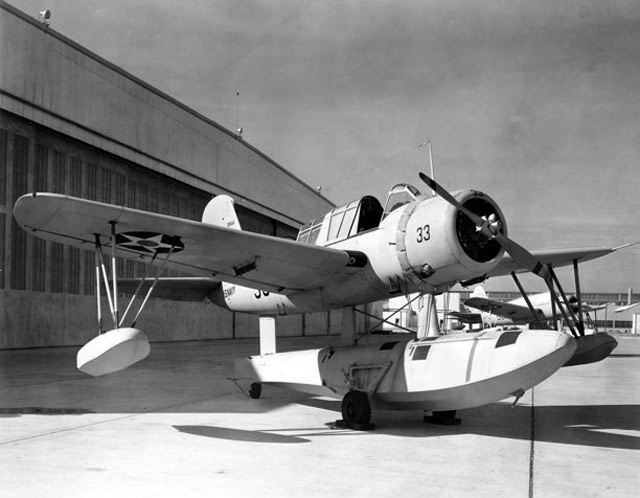 |
| A US Navy Vought OS2U Kingfisher seaplane on the ramp at Naval Air Station Jacksonville, Florida, 7 June 1942 (US Navy). |
Battle of the Atlantic: U-653 (Kptlt. Gerhard Feiler), on its third patrol out of Brest, torpedoes and sinks seaplane tender USS Gannet (AVP-8) northwest of Bermuda. The ship sinks within four minutes. PBM Mariner seaplanes of VP-74 rescue 22 men, while USS Hamilton picks up 40 more. There are 16 deaths.
U-159 (Kptlt. Helmut Friedrich Witte), on its second patrol out of Lorient, torpedoes and sinks 3382-ton US freighter Edith 200 miles southeast of Kingston, Jamaica. The ship sinks within twelve minutes. Witte surfaces after the attack to question the survivors and give them direction. He also, in an unusual move, scavenges various supplies that are bobbing in the water such as food, clothing, and even toys. The ship's survivors make it to Black River, Jamaica, in a week.
Italian submarine Leonardo da Vinci torpedoes and sinks 6956-ton British freighter Chile 350 miles southwest of Monrovia, Liberia. There are five deaths and 39 survivors.
U-107 (Kptlt. Harald Gelhaus), on its sixth patrol out of Lorient, torpedoes and sinks 3910-ton Honduran freighter Castilla near Jamaica. The ship sinks within minutes and no lifeboats can be launched. There are 24 dead and 35 survivors, who are picked up by USS Nike (WPC 112).
U-107 also torpedoes and sinks 3249-ton US freighter Sterling Steel Bridge (formerly Suwied) near Cozumel, Mexico. The ship sinks within three minutes, preventing any distress calls. There are six dead and 27 survivors. The survivors are picked up after 19 hours by USCGC Nemesis (WPC 111). This sinking, which occurs around midnight, is sometimes cited as occurring on 8 June.
U-158 (Kptlt. Erwin Rostin), on its second patrol out of Lorient, torpedoes and sinks 5234-ton Panamanian freighter Hermis due west of Havana, Cuba and due north of the extreme western tip of Cuba. Despite being hit by two torpedoes, the ship remains afloat and steaming in a circle, so Rostin surfaces and shells the freighter, setting it on fire, but it remains afloat for 12 more hours. There are one death and 46 survivors, who are picked up by US Army transport Toloa and taken to Kingston, Jamaica.
German 2967-ton freighter Joao Pessoa strikes rocks and sinks two miles from San Sebastian, Spain. Casualties are unknown.
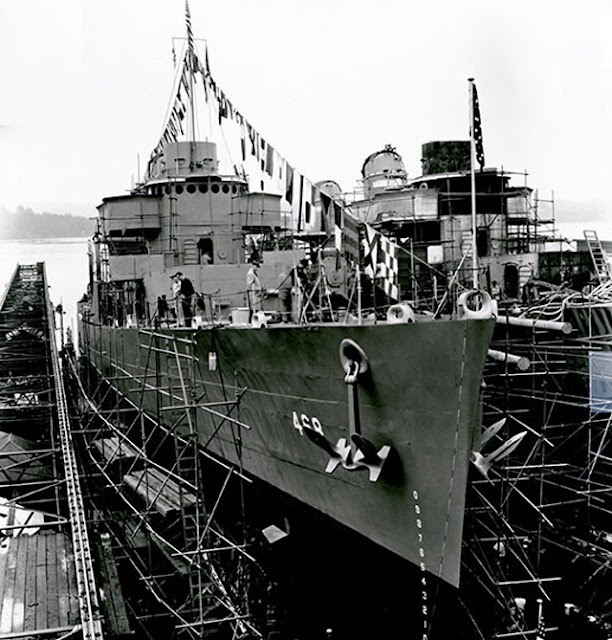 |
| Launch of USS Taylor (DD-468) at the Bath Iron Works in Bath, Maine, on 7 June 1942. The ship is named after Rear Admiral William Rogers Taylor (US Taylor Reunion Association). |
Battle of the Mediterranean: The Axis forces around Bir Hakeim continue small-scale attacks. The 90th Light Division has managed to send pioneers through one minefield and into an interior minefield within about 800 meters (900 yards) of the fortress. The Free French garrison, while low on supplies, continues to hold out. During the day, the British Desert Air Force (DAF) launches several attacks against the exposed pioneers, while Luftwaffe Stukas pound the fort.
Much of the fighting at this stage of the battle revolves around supply lines, which are of vital concern in the desert. The British launch minor attacks by the 7th Motor Brigade and 29th Indian Infantry Brigade against Axis supply lines without much success. One last convoy manages to get through to Bir Hakeim in heavy fog after dark. Meanwhile, German General Erwin Rommel use the fog to reposition his forces for a determined assault on Bir Hakeim from the north on the 8th.
Besieged within Bir Hakeim, Brigadier General Marie-Pierre Koenig requests permission to withdraw due to his supply problems. Lieutenant-General Neil Ritchie, commanding the British Eighth Army, denies the request. Ritchie has his reasons - he anticipates the loss of Libya and needs to buy time while he builds a last-ditch defensive position at the little Egyptian town of El Alamein. Koenig, knowing that he can't hold out much longer, begins contemplating a breakout.
Italian submarine Sebastiano Veniero (Cdr Elio Zappetti) is lost due to two Catalina attacks of RAF No. 240 Squadron between the Balearic Islands and Sardinia around noontime. All 57-58 men on board perish.
 |
| USS Gannet, sunk by U-653 on 7 June 1942. |
Special Operations: British Commandos execute Operation Albumen, another in a long sequence of overnight operations against Axis coastal targets. This one is on the Greek island of Crete, where Luftwaffe forces have been supporting the currently successful campaign of German General Erwin Rommel in Libya. Operation Albumen has several different coordinated sabotage operations.
Led by Captain G.I.A. Duncan of the Black Watch and assisted by local partisans, the Commandos destroy five aircraft and damage 29 others, along with several vehicles and stores, at Kastelli. At Heraklion, George Jellico leads members of the Free French Forces and Hellenic Army to plant Lewes bombs, destroying about 20 Junkers Ju 88 medium bombers. Similar attacks at Tympaki and Maleme do not accomplish anything because there were no aircraft at the former location and the latter was too well guarded. The Germans lose a dozen soldiers.
Aside from the damage caused directly by Operation Albumen, there are some lasting consequences. While the Commandos escape, the German authorities take and execute 50 local hostages. German Crete commander General Alexander Andrae ultimately is replaced by General Bruno Bräuer in November 1942 partly as a consequence of this raid.
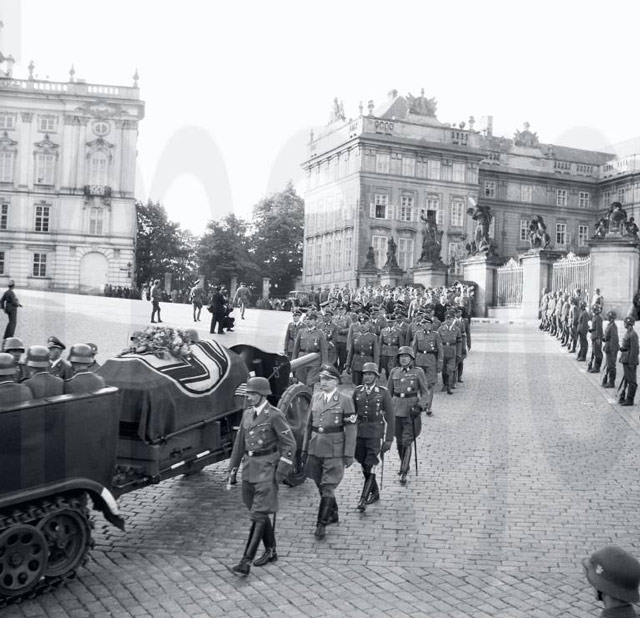 |
| Funeral procession of Reinhard Heydrich in Prague, 7 June 1942. Note his flag-draped coffin on a caisson on the left. |
German Homefront: The German authorities in Prague hold a massive, ostentatious funeral for assassinated Reichsprotektor Reinhard Heydrich. Afterward, the coffin is sent by train to Berlin for a second funeral to be held on 9 June. The second funeral is planned to be even more elaborate and ostentatious and is to be attended by the entire Reich leadership including Adolf Hitler. The Prague authorities continue to search for the assassins, who remain in the city moving between safe houses. Severe reprisals are in progress, with many more planned.
British Homefront: Scientist Alan Blumlein, the inventor of stereo sound recording among many other things, dies when a Halifax bomber in which he is testing H2S airborne radar crashes in Herefordshire. The crash apparently is due to improper aircraft maintenance. Due to Blumlein's importance to the war effect, the British government does not announce Blumlein's death until 1945. This delay leads to various conspiracy theories about the true cause of Blumlein's death. In 2017, the US Recording Academy posthumously awards Alan Blumlein a Technical Grammy for his contributions to the recording field.
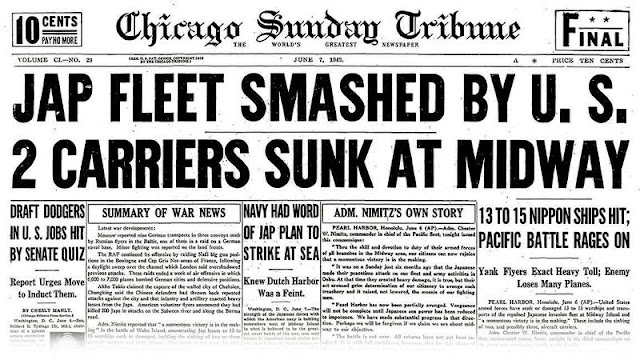 |
| The 7 June 1942 Chicago Sunday Tribune, featuring the article in the center "Navy Had Word of Japanese Plan to Strike at Sea" which almost got the reporter and newspaper in big trouble. |
American Homefront: In a remarkable journalistic coup, the Chicago Tribune breaks the news of the codebreaking that contributed heavily to the US Navy victory in the Battle of Midway. Under the headline "Navy Had Word of Japanese Plan to Strike at Sea," the article describes how Naval Intelligence allowed Admiral Nimitz to pre-position his forces to ambush the Japanese fleet. While this article displays a clear breach of critical military security that might aid the Japanese, nothing comes of it. The Japanese military shows no signs of becoming aware that the Americans have broken their codes.
In Great Britain, Winston Churchill is known for having a short fuse with regard to sensitive press leaks like this. His government engages in many displays of censorship and attempted censorship. However, the US government ultimately lets the matter pass because events show that the disclosures do not interfere with the war effort.
Future History: Muammar Muhammad Abu Minyar al-Gaddafi is born in Qasr Abu Hadi, Sirte, Italian Libya. From a poor tribal family, he joins the Libyan military in 1963. In 1964, Muammar Gaddafi forms the "Central Committee of the Free Officers Movement," a revolutionary group styled after the teachings of a former Egyptian leader. In mid-1969, while Libyan King Idris is on vacation in Turkey and Greece, Gaddafi leads a bloodless coup and established the Libyan Arab Republic. Self-styled as the "Brotherly Leader and Guide of the Revolution of Libya," Muammar Gaddafi thereafter rules Libya as a dictator. He develops a cult of personality and remains in power until 20 October 2011, when Muammar Gaddafi perishes while trying to flee from an insurrection.
2021
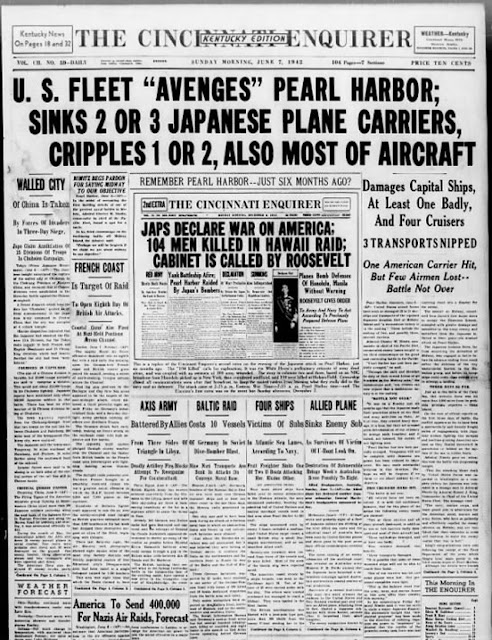
No comments:
Post a Comment